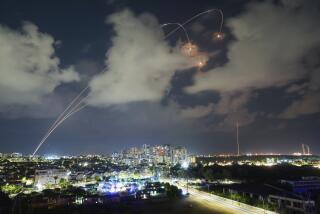Backers Encouraged Before Talks With U.S. : Test of Israel’s Lavi Jet Fighter a Success
- Share via
JERUSALEM — Israel’s controversial Lavi jet fighter made what its test pilot termed a successful 30-minute maiden flight Wednesday, three months behind schedule but four crucial days before the arrival here of the plane’s key Pentagon critic.
The flight was seen here as a preemptive strike by proponents of the Lavi who would otherwise have been in a much weaker position to debate alternative American proposals expected to be put forth when U.S. Deputy Undersecretary of Defense Dov S. Zakheim arrives on an official visit Sunday.
Washington has underwritten the bulk of the estimated $1.3 billion spent to develop the fighter, and if the program goes ahead American taxpayers are expected to pour in billions more to build 300 Lavis by the year 2000. Lavi development funds come out of $1.8 billion in annual U.S. military aid to Israel.
“There are still many obstacles but I have no doubt that the first takeoff of the prototype and its safe landing are an important benchmark in the development of the Lavi,” Defense Minister Yitzhak Rabin told the Israeli Parliament on Wednesday in announcing the inaugural flight test.
Advanced Millstone
Critics warn that the Lavi, which means “lion” in Hebrew, has become a technologically advanced millstone around the neck of Israel’s already struggling economy.
If the project goes ahead, they predict, Israel, which is already the largest recipient of American aid, will soon be back in Washington seeking even more money. And the United States will face the unhappy choice of either agreeing or watching passively as the economic strain of the program erodes the strength of its most important Middle East ally.
The Pentagon, which would like to see Israel buy American fighters rather than build its own, contends that the country has underestimated the cost of each Lavi by nearly 50%.
Detractors in Israel
But the Lavi has numerous detractors in Israel, as well, particularly in the defense Establishment among officers who argue that other branches of the military are already suffering because so much money is being drained by the fighter program. The military criticism became so intense earlier this year that Chief of Staff Maj. Gen. Moshe Levy ordered senior officers to keep their negative opinions about the Lavi to themselves.
Lavi proponents here dispute the Pentagon’s cost estimates. They say the aircraft will be the most advanced of its type in the air and a necessary addition to Israel’s arsenal if the nation is to remain technologically ahead of its potential Arab enemies into the next century.
Moreover, they argue, the Lavi represents much more than just a new warplane. They compare its economic impact, particularly in cultivating high-technology industry, with that of America’s race to the moon, and contend that its psychological impact may be comparable as well.
To Evaluate Alternatives
Israel nevertheless agreed previously to evaluate alternatives to the Lavi proposed by the Pentagon. And it is those alternatives that Zakheim is expected here to discuss next week.
Among them is believed to be a version of the American-made F-16 modified with Israeli-developed electronic and avionic systems.
“We are waiting for Dov Zakheim,” commented Lavi project director Menachem Eini on Wednesday. “He will propose alternatives, many of which will have nice aspects. But the one thing they won’t give Israel is a contribution to Israeli industry and technology.”
Radio Israel quoted Lavi test pilot Menachem Shmul on Wednesday as saying that the new fighter handled better than any other aircraft he has ever flown.
“I found the aircraft response very crisp and smooth,” Shmul said, adding that it was nevertheless too soon to say whether it has a combat edge over other fighters. Radio Israel said Shmul flew the plane at differing speeds up to an altitude of 12,000 feet during the half-hour test.
28-Foot Wingspan
Measuring only about 50 feet long, with a 28-foot wingspan, the Lavi is a veritable laboratory of the latest computer and avionics technology and is designed to fly at a top speed of more than 1,300 m.p.h. It incorporates so-called stealth technology to make it difficult to detect on radar.
The first Lavi prototype was originally scheduled to make its maiden flight late last September, but a series of technical problems, including the late delivery of some American-made components, delayed the takeoff.
More to Read
Sign up for Essential California
The most important California stories and recommendations in your inbox every morning.
You may occasionally receive promotional content from the Los Angeles Times.













